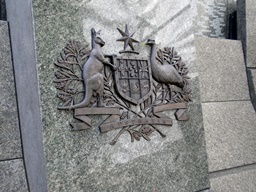 Geologist and science writer Nina Morgan reflects on war memorials to the ANZAC fallen
Geologist and science writer Nina Morgan reflects on war memorials to the ANZAC fallen
As popularity of the Love and Sorrow exhibition, now running at the Melbourne Museum in Australia highlights, war graves and monuments to ANZAC soldiers killed during the First World War still hold great meaning in Australia. The fact that along with the death of their sons, brothers and husbands, many Australian families suffered the further loss of never being able to afford to visit the grave of their fallen – or even to know the comfort of being able to include an epitaph on the gravestone – only adds to their poignancy.
In Australia, families of the fallen who wanted to add an epitaph to the standard war grave were charged threepence ha’penny for every letter and every space. This was an expense that many could not afford, and vigilant officials pursued families into the 1920s for failure to pay. The War Graves Commission also exercised a form of censorship and reserved the right to veto any epitaph it deemed inappropriate. Many grieving mothers, fathers and wives were told that their last message was too long, cumbersome, inartistic or even too sentimental.
Prosperous
Now that people are more prosperous and travel is easier, regular tours are organised to the cemeteries and memorials to the ANZAC fallen in Gallipoli. The tower of Australia's National Memorial, erected at Villers-Bretonneux in France in memory of the more than 800 Australians killed on the Somme during the First World War is a also place of pilgrimage for many. Although this handsome structure, designed by Edwin Lutyens and made of what appears to be Portland stone, shines out bright white on the horizon – it was never meant to be like that.
The original plans stipulated that this monument should be built entirely of Australian stone. The idea was to freight stone thousands of miles across the oceans to plant a piece of Australia in France, in effect to bring a piece of home to the Australian soldiers who – because of the decision not to repatriate ANZAC dead – would never see their homeland again. But the Great Depression after the war intervened. Funds ran out, and the plan for a uniquely Australian memorial was never actually realised.
Hyde Park Corner
But many years later, this dream was granted – to a degree. The Australian War Memorial in Hyde Park Corner London (picture), designed by the Australian architectural firm Tonkin Zulaikha Greer and the Sydney-based Australian artist Janet Laurence, which was completed in 2003, commemorates the efforts of the Australian Servicemen, allied with those of Great Britain, in both World Wars. It is clad in a 2.6Ga green granite from the Yilgarn Craton near Jarramungup in SW Australia. Cut in Australia and shipped to London, the stone – known in the trade as Verde Laguna – is composed of blue-green microcline feldspar, hornblende, plagioclase and quartz.
Acknowledgements
Information about the stone used in other Australian war memorials has proved hard to find. Perhaps readers can help? This vignette was inspired by the Monash University online MOOC course, World War I: A history in 100 stories available on www.futurelearn.com. Other sources include an article by Ruth Siddall, The Stones of London's War Memorials: Urban Geology in London No. 23, published in 2014 and available from: www.ucle.ac.uk/~ucfbrxs/Homepage/walks/WarMemorials.pdf, and information about the Australian War Memorial at www.tzg.com.au/project/aus-war-memorial/ and Wikipedia.
* Nina Morgan is a geologist and science writer based near Oxford. Her book, The Geology of Oxford Gravestones, is now published and available from www.gravestonegeology.uk